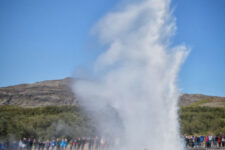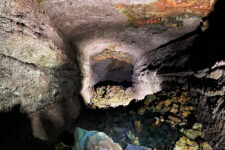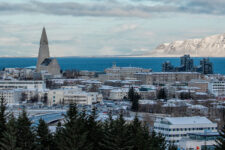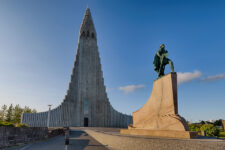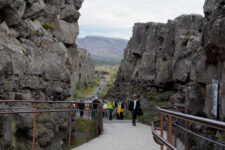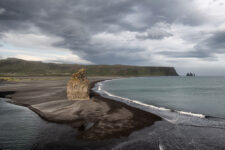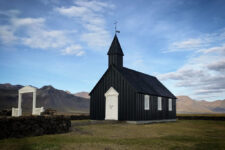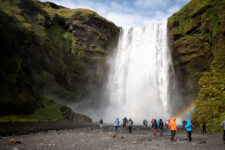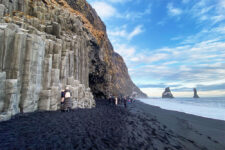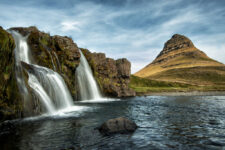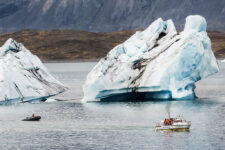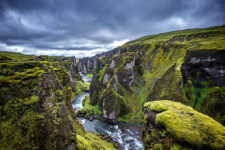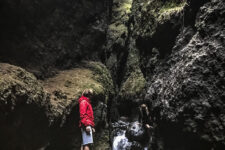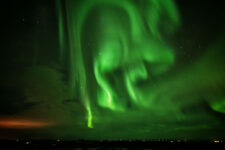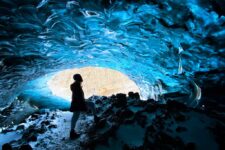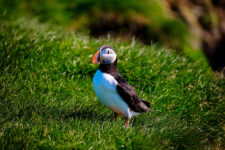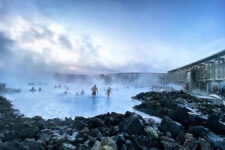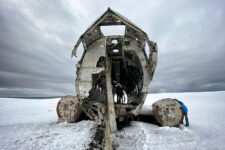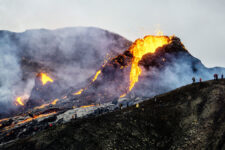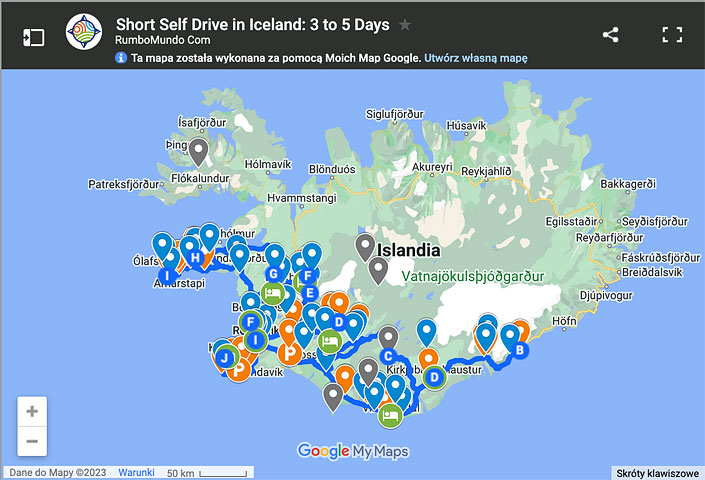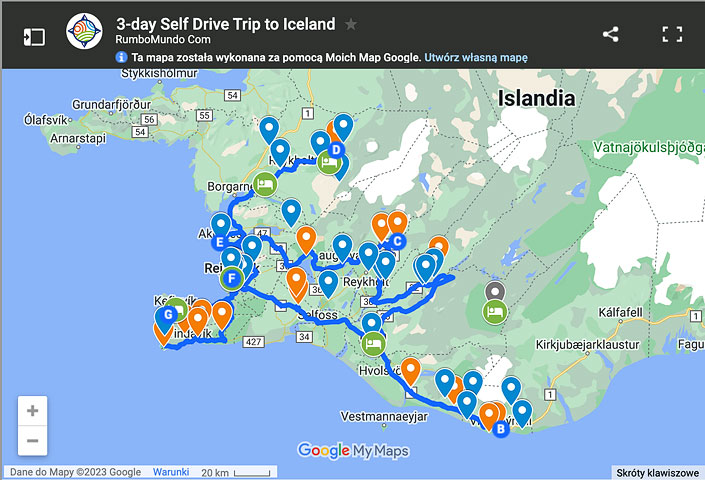If you only have a few days at your disposal, but want to see as many of Iceland’s amazing attractions as possible – this travel plan is exactly for you.
The basic version of this plan is a 5-day trip. You won’t get around the island in that time, but many of the most important and interesting attractions of Iceland are absolutely within your reach.
You will also find a shortened, 3-day plan below, as well as an extended version – a plan and detailed itinerary for 7 days. If you’re coming for more than 7 days, then proceed to our 7 to 13 days itinerary based on getting around Iceland on famous route 1.
Top places to see in 5 days in Iceland
On a short trip to Iceland you will focus on visiting the south, south-west and west parts of the country. You will stay relatively close to the capital Reykjavik and the international airport in Keflavik, but more importantly: this part of Iceland has lots and lots of attractions packed on a relatively small area. So you can really see a lot in limited time and with limited driving.
The highlights of the 5-day itinerary include the so-called Golden Circle (including the famous Geysir and the continental rift in the Thingvellir National Park), black beaches, several glaciers, Diamond Beach and Jokulsalron Bay, countless waterfalls and volcanoes (including the newest – Litli-Hrutur), lava caves and ice caves (especially if you go in winter), the beautiful Cape Snaefellsnes and any number of hot springs.
Photos below show just some of the attractions you’ll see on your trip. And as you can see they are aplenty…
Basic options and recommendations
As mentioned above and as you’ll see on the map a little further down, on a 5-day trip you definitely want to focus on the South and South-West of the country.
The map further down shows a number of routes you can follow – just click on the map to activate it, perhaps enlarge it, and click again in the top left corner to expand map’s menu. You can tick and un-tick all the layers there, which should give you a clear picture of your options.
But let’s start with a few fundamental decisions.
If you’re coming in summer (late June to early September), you will do well to rent a 4×4 car and get a glimpse of the interior on your tour. If you can plan your trip for 7 days (or 5 minimum), you can absolutely visit beautiful places like Thorsmork, Landmannalaguar, Kerlingarfjoll, Vestmannaeyjar or Westfjords as you go. It’s just that each of them requires adding at least one extra day to your travel plan, so you can only pick two of them, if you want to extend from 5 to 7 days etc. Go to section 7-day self drive: great extras further down for all the details and recommendation on what to add first. And see a dedicated layer on the map below.
Winter trip specifics
If you are coming to Iceland in winter, this plan here is still your best starting point for planning your itinerary and places to visit. Just plan to go slower, as there won’t be as much daylight for your sightseeing and the road conditions might be far from perfect. You can consider additional attractions in itineraries below as a back-ups – places you can visit should you not be able to get to the main ones for one reason or another.
When planning a winter trip you should definitely consult our article dedicated to traveling in Iceland in winter: Winter trip to Iceland – a Complete Guide.
Self drive vs guided tours
In our opinion visiting Iceland on your own, on a self drive is always the winning option. There is a number of advantages to it and that’s what we focus on in this guide. Skip to the next paragraph if you’re planning on a self drive.
But it’s fully understandable if you’d rather get on guided tours instead. It will likely be more expensive and you have to go along with the group, but you don’t have to worry about (most of) the formalities, the rental, finding your way etc. You will be taken care of AND the guides will tell you all there is to know (and more) about the places you visit as well as Iceland history, culture and nature.
A
void a common mistake and don’t book all of your nights in Reykjavik, even if you only want to do the guided tours. Being fully based in Reykjavik generally rules out visiting Jokulsarlon and that would be a shame, really. Plan around a 2 or 3-day South Coast tour instead and so don’t plan to spend those nights in Reykjavik.
If you want to go with guided tours only, your first choice should be a 3-day South Coast tour, supplemented by a 2-day West Coast tour. This is the easiest and most comfortable way of seeing Iceland in a nutshell without renting a car. You will – obviously – top it with sightseeing Reykjavik itself, but this you can easily do on foot, following our guide here: Sightseeing Reykjavik – Top Things to See and Do.
This general plan is valid for any season, but certainly a bit more valuable in wintertime as many tourists (and quite reasonably so) don’t want to take the risk of winter driving in Iceland. Here’s our picks for those:
If you want to spend more nights in Reykjavik and book the Golden Circle tour separately, than the 2-Day South Coast Tour is a good alternative, too (replacing the 3-day version above).
And if you’ve already booked all your nights in Reykjavik or if you’re happy to sacrifice seeing Jokulsarlon and the Diamond Beach for the extra comfort of spending all of your days in the same “base camp”, then you need to start from (in order of importance) booking a Golden Circle tour, then go for a South Coast tour, Snaefellsnes tour and the Silver Circle tour. This is of course the order of importance only – feel free to book them in any sequence that suits you.
If you have a little more time and/or if there’s (again) a volcano spitting lava in the Reykjanes peninsula, than you definitely want to include a tour to there. See the following page for the latest news on Reykjanes volcanos and ways of seeing them: Iceland’s Latest Volcanic Eruption.
5-day self drive plan for Iceland
All our recommended self drives start and end at Keflavik Airport. That’s where you should pick up your rental car and where you’ll be dropping it off. You can easily readjust for Reykjavik, but consider the following:
- Reykjavik is a cute town, but it isn’t one of Iceland’s wonders – you can leave visiting it for the end of your trip and just a few hours will be perfectly enough for this;
- Selfoss is a nice town east of the capital, where you can spend the night. Staying there will save you some driving for the following day; hotels and guesthouses there offer better availability and lower prices; and there’s a very nice matholl (food hall) there, where you can eat out;
- picking up the car at Keflavik will likely pay for itself right away, as a shuttle bus to Reykjavik is about $30 per person (about 1-hour ride), so usually it will be less expensive to just rent the car for one more day, even if it is only for getting to Reykjavik;
- there’s only a handful of rental companies operating INSIDE the arrivals hall, but almost ALL companies offer a quick transfer to their HQ somewhere in airport vicinity; so you’re not limited to the largest, often more expensive, brands – you can use any local company just as well;
- in our experience Discover Cars offers best prices, widest selection of cars and most user-friendly interface; see our detailed guide Renting a Car in Iceland – a Complete Guide for more;
- and if you decide for a campervan or a motorhome, then 99% of times you get the best offer at Motor Home Republic; again, see the car renting guide above for a lot more details;
If
you arrive at night, consider the alternative plan further down. If you can bear a bit of extra inconvenience up front, it will greatly improve the remaining days of your trip.
Finally, the map below may look a bit cluttered. Click it to activate it and then perhaps expand it to full screen. In the left top corner you’ll notice a menu icon (left of the Rumbomundo logo). If you click it a side menu will slide in and you’ll be able to tick and un-tick individual layers of the map. Reviewing the layers one by one, or just hiding those that are of no interest to you, makes the map a lot more informative.
Map: 3 to 5 days self drive in Iceland – itinerary
The map shows (on separate layers) the main attractions (orange markers), additional attractions (blue), accommodations (green), possible places to spend extra days (gray) and the recommended driving route (4×4 and ordinary versions). You can turn each layer on or off separately for readability. If you click the star to the right of map’s title, the map will be saved to your Google account, so you can come back to it any time and at any of your devices, right inside the Google Maps app.
If you need to stock up on groceries remember that Bonus shops will usually be the least expensive, while Kronan network will offer very similar prices at the bottom shelf, but a lot more selection in higher quality products. And if you need to do your shopping outside the office hours, then know that the Netto market at Þönglabakki 1 (109 Reykjavík, Iceland) works around the clock. See this piece for all the details on products, prices and grocery networks in Iceland: Grocery Shopping in Iceland: Prices and Store Opening Hours.
If you need to buy camping gas then N1 gas stations are great for that. The one right off the BSI bus terminal works 24/7 on weekends and 6AM to midnight on all other days.
L
eave the
Reykjavik sightseeing for the final day of your stay. One doesn’t come to Iceland to experience restaurants and museums after all. Make it your ‘buffer point’. Should anything happen while you travel and you need to drop something from your plan, Reykjavik should be that thing. Begin with waterfalls, gorges, geysirs, volcanoes and hot pools, and leave the town for the end. Or for when it’s convenient. Just don’t prioritise it.
Individual days in the itineraries below, are planned for relatively intensive sightseeing in spring and autumn. If you’re visiting in these seasons, you should be able to follow them 1:1.
If you’re visiting in summer, you’ll have a lot more daylight to work with and so you can plan even more activities, if don’t ever get tired. You can compress five days plan into four days, you can add some hiking in selected places or you can spend the extra time in the hot springs, too. Review carefully the additional attractions and extras we indicate for each day.
Finally those who come in winter, have to review these plans with very short days in mind. Some attractions might be inaccessible due to bad road conditions, other may be closed for winter. We do point them out below, but winter is unpredictable, so be extra flexible. Consult our Guide for winter traveling in Iceland and enjoy the fact that you can visit the most beautiful ice caves and have a real chance to see the northern lights. Winter visits to Iceland will often be super rewarding!
Detailed 5-day self drive itinerary (main version)
This main version of the plan assumes that you land during the day (local time) and/but don’t want to start right away. So you spend the remaining day relaxing.
Either you’re arriving late in the day, or you expect to be fighting a jet lag, or you just like to go slow and keep a relaxed tempo. So stay near Keflavik, in Reykjanes peninsula or go to Reykjavik and have a walk around the city.
If
you want to squeeze every hour and minute of your stay to see as much as possible, and especially if you’re arriving in the evening or at night, then the alternative plan further down is designed for you. Do have a look at it – you might like it even if you arrive in the afternoon.
And if you arrive in the morning and want to hit the ground running, then skip Day 0 below and start immediately at Day 1 further down. Keep it up! You’ll rest on your flight home! 🙂
Day 0: arrival, Reykjanes, overnight
If you don’t want to push it, and you’d rather start your trip from just getting to know Iceland a little bit, you have three basic options to choose from:
- SPA afternoon
Pick up your car at the airport or take one of the tours that take you directly from the airport to the Blue Lagoon and later, when you leave, drop you off in downtown Reykjavik; there is large lockers at Blue Lagoon, so you can absolutely take all your luggage with you;
- Reykjanes tour
There’s plenty to see right on the Reykjanes peninsula, where the airport is located. It’s a bit of a waste of time to drive away from here (to Reykjavik, for example) just to come back on a later date. You especially don’t want to do that on a short trip. If Reykjanes volcano is active again, than that’s your priority. Else – visit the cliffs, the hot springs, the bridge between Europe and America and all the other interesting places in Reykjanes. You’ll find a list and a review of them, with lots of photos in Grindavik Surroundings – Top Things to See in the Reykjanes Peninsula.
- Reykjavik stroll
If you want to immerse youserlf with Iceland by taking a walk around an Icelandic city, then certainly Reykjavik is the place to go. Follow our guide Sightseeing Reykjavik – Top Things to See and Do, where – among lots of tips, photos and general advice – you’ll also find a map with a plan for a nice, informative walk around the city. If you do come to stay here for your first night, perhaps prioritise visiting Perlan, as this will give you a lot of background to the rest of the trip.
And remember that indeed Sky Lagoon certainly is the #1 hot pool in the city, but there’s plenty of other ones to choose from, so you don’t need to limit yourself to Sky (although it certainly is worth visiting). See this article for a comprehensive review of Hot Pools in Reykjavik.
overnight accommodation: Keflavik, Reykjavik, Selfoss; Grindavik is also a good choice, if it has recuperated from the earthquakes of 2023.
Some suggestions:
- Keflavik:
Lighthouse-Inn, Aurora Hotel (200 m from the airport), V13 Guesthouse, Brimarsbrú sleep inn-art Gallery (airport transfer available, by arrangement), Courtyard by Marriott Reykjavik Keflavik Airport;
- Selfoss:
good value-for-money places: South Central Guesthouse, Bella Apartments, Hotel Selfoss, Hotel South Coast;
cabins and cottages: Home in Selfoss, Bjarmaland Cottages, Blue View Cabin, GC Luxury Cottages;
if you arrive in winter, maybe try one of these top aurora hunting venues: Golden Circle Domes or Bubble Hotel Hrosshagi;
- Grindavik:
Guesthouse Grund, R&J Guesthouse Room, Hótel Grindavik, Harbour View Cottages Grindavik, Kristinsson Apartments or the Converted Water Tower;
- Reykjavik:
campgrounds and hostels are available; it’s a good idea to choose something downtown so you don’t have to commute for sightseeing and dining, but places outside a walking distance from the city centre will obviously be cheaper, and there city buses (and taxis) will take you anywhere; if you’re a budget traveller, check out Central Guesthouse, Apartments Reykjavik, 101 Guesthouse, Dalur Hostel (the one at the main campsite) and Bus Hostel. And if you’re happy to spend extra for higher standard accommodation, we’d recommend Reykjavik Marina and Rey Apartments;
If you’ve decided for a camper, RV or you’re sleeping in a tent, then definitely choose either the Reykjavík Langidalur Campsite or certainly less crowded Grindavik campsite.
Day 1: South Coast
Perhaps contrary to some intuition don’t start with the Blue Lagoon, Reykjavik and the Golden Circle. You’ll have ample time to see them in the following days. Instead take Route 1 east, enjoying the landscapes and start your more serious sightseeing with Seljalandsfoss waterfall. Along the way you can stop for shopping at one of the Bonus, Kronan or Netto (preferably in Keflavik or Selfoss). Vinbudin liquor store at the end of the tour (in Kirkjubaejarklaustur) is open from 1 to 7 PM, if you’re interested.
route: Keflavik – Kirkjubaejarklaustur [300 km / 185 mi]
main attractions: waterfalls Seljalandsfoss and Gljufrabui and Skogafoss, famous Reynisfjara beach and the Dyrholaey peninsula, Fjadrargljufur canyon (you can also leave it for another day);
additional attractions: Reykjadalur hot stream, Kerid crater, old Seljavallalaug pool, Solheimajokull glacier, DC3 wreck (on Solheimasandur beach), Yoda cave (Hjörleifshöfði), a trip to Laki Volcano (F206, about 80 km, summer only and 4×4);
accommodation: Kirkjubaejarklaustur campground (Tjaldsvæðið Kleifar; Camping Card works, but showers cost extra); hostel: Hvoll Hostel (about 25 farther east); guesthouses: Klausturhof Guesthouse, The Holiday Houses, Hotel Laki or in higher quality: Magma Hotel; there’s more selection of places to stay around Vik, but that leaves you with significantly more driving for the following day (about 160 km / 100 mi more), but if you’re OK with the extra driving than The Barn is our #1 favorite hostel in all of Iceland, while Black Beach Suites and Hotel Vík í Mýrdal are likely the top hotels.
note: you spend two consecutive nights at the selected location;
- Seljalandsfoss and Skogafoss are two of Iceland’s absolute top waterfalls; and Fjadrargljufur is perhaps the most beautiful canyon while Reynisfjara is Iceland’s most famous black beach; this day really is full of top attractions;
- a beautiful Fimmvorduhals trail (Fimmvörðuháls gönguleið) starts at the top of Skogafoss waterfall; you can hike it a bit up the mountain to see more beautiful waterfalls; about 1 or 2 hours up should be perfectly enough; if you want to hike all the way to the huts on the high pass and back, it is rather a full day hike, so no time for that on a short trip;
- At the end of the route, past Vik, on both sides of the road you’ll see beautiful lava fields already overgrown with mosses and lichens. It is worth stopping at one of the parking lots along the way to see them up close;
Day 2: to Jokulsarlon and back
route: Kirkjubaejarklaustur – Jokulsarlon – Kirkjubaejarklaustur [approx. 250 km / 155 mi]
main attractions: Svartifoss waterfall, remains of Skeidara bridge, Skaftafellsjokull glacier (next to Svartifoss) or Svinafellsjokull (just see one of them), Jokulsarlon Lagoon and the Diamond Beach, ice caves near Jokulsarlon, if you’re visiting in wintertime;
additional attractions: Katla ice cave tour if you’re visiting outside of winter and/or could not visit the Jokulsarlon ones for any reason, Fjallsarlon bay, Jokulsarlon bay cruise, trekking at Svartifoss, possibly Fjadrargljufur and Laki if you didn’t see them the previous day (or if you didn’t see them enough 🙂 );
overnight stay: Kirkjubaejarklaustur – same as the previous night;
- it’s definitely worth going to at least one of the glaciers – see them up close, hear how they work; climbing them is dangerous, but Svinafellsjokull, for example, usually has a path leading quite far, and on Skaftafellsjokull you can get right to the very front of the glacier; if that’s not enough and you really want to hike the glacier for a few hours, than the Solheimajokull 3-Hours Glacier Hike is your top pick;
- you will find the most beautiful icebergs on the Jokulsarlon bay, but the front of the glacier looks a lot better on the Fjallsarlon bay, because it’s a lot closer to the viewing points;
- if you decide for a cruise on Jokulsarlon, it is worth paying extra for the RIB / zodiac tour as it gets much closer to the (already heavily receded) glacier; you’ll find more options and tips in our Jokulsarlon Lagoon and the Diamond Beach review;
- Fjadrargljufur is best seen from the upper view point and parking; but from the lower parking lot you can go inside the canyon;
- The trip to Laki is seemingly only less than 100 km round trip, but the volcano – although famous and very interesting to geologists (see Most deadly eruption: 1783) – is unlikely to look anything spectacular, and the road requires slow, careful driving; make sure to check road.is for current road conditions and ask the campground or hotel staff if your car can handle it;
- possible extra day: Landmannalaugar
You can “insert” a visit to the amazing Landmannalaugar here (i.e. on the following day). An absolutely spectacular option, but only available in summer.
If you have a good 4×4 car and are not afraid of fording some streams, then take F208 north and reach the beautiful rainbow mountains on your own. Spend the afternoon and possibly the following morning hiking the trails there, and then go further north and onto Route 32, west to Fludir.
If you don’t drive a 4×4 or would rather not risk fording any rivers, then you have to ‘attack’ from the west. You need to drive all the way to Rjupnavellir (215 km / 135 mi west of Kirkjubaejarklaustur; route 1 and then 26) and get on a highland bus to Landmannalaugar there. You can spend the night in Landmannalaugar or take an evening bus back to Rjupnavellir (but that leaves you with very limited time on-site). Remember to book your bus tickets in advance!
Day 3: through the Golden Circle to Borgarnes
It’s quite a long day and a lot of driving, but the beautiful attractions will reward you for any hardships. If you want, you can now see some of the additional attractions that you possibly ran out of time for on the first day (e.g. the DC3 wreck?).
route: Hella – Haifoss – Golden Circle (northern part) – Thingvellir – Borgarnes [approx. 370 km / 230 mi]
In winter, from Hella, continue on Road 1 and turn onto Road 30 to Fludir, because you won’t see Haifoss in winter anyway, and the northeastern section of Roads 26 and 32 has no winter/snow service, so you’re unlikely to clear it.
In summer (if you drive a 4×4) you can turn north from the Thingvellir area onto the beautiful F550 road and drive straight to Husafell. You will see beautiful views and save yourself a lot of distance.
If you went to Landmannalaugar, you join this route near Haifoss.
If you’re on a 3-day trip, then after visiting Thingvellir you go straight to the airport; if you have a couple of hours of slack – see Reykjavik on the way; 2-3 hours are fully sufficient for this – see: Sightseeing Reykjavik – Top Things to See and Do.
main attractions: National Park Thingvellir, geysers Geysir and Strokkur, the waterfalls of Gullfoss and Haifoss;
additional attractions: a hot sand bread-baking demonstration at Laugarvatn Fontana (and the hot pools there), the hot pool at Fludir (Secret Lagoon) or Hrunalaug hot spring nearby, Fridheimar restaurant, caves in Hella, trekking to Mount Esja (beautiful views of Reykjavik), hot spring on the beach in Akranes (Guðlaug Baths);
accommodation: Borgarnes, e.g.: Englendingavík Homestay, Laekjarkot Rooms and Cottages, Hotel Hafnarfjall or (slightly more expensive, but also better) Hotel Hamar; alternatively: the excellent ‘capsules’ Fossatún Camping Pods or the guesthouse Gamli Bær near Husafell;
NOTE: it will work well again to stay at the same place for 2 consecutive nights (unless you’re taking the extra day trip to the Westfjords);
Day 4: Snaefellsnes
Cape Snaefellsnes is called “Iceland in miniature”, because the attractions here are numerous, diverse and represent all the top “categories”. You’ll see waterfalls, volcanoes, black beaches, lava fields, a cave, a beautiful mountain, and, well, probably the prettiest church on the whole island.
In addition, the Bjargarsteinn Mathús restaurant in Grundarfjordur is ranked among the best in all of Iceland! If you want to go on a splurge and taste the best Icelandic cuisine, this is the perfect opportunity to do so.
If you can manage it, a trip to the Husafell area is also absolutely wonderful, but the whole thing then grows to about 500 km (310 mi) and 7h of driving (+ 5-6h for sightseeing), so it makes for a really long day. Unless, of course, you’re visiting in summer and in a 4×4 car, and the previous day you chose to go via F550 with an overnight stay in Husafell. In that case, start with a morning tour of Vidgelmir Cave and only then head toward Snaefellsnes, seeing additional attractions in the area along the way (Hraunfossar and Barnafoss, Deildartunguhver and Grabrok).
route: loop: Borgarnes – Grundarfjordur – Arnarstapi – Borgarnes [290 km / 180 mi]
main attractions: mountain Kirkjufell and Kirkjufellfoss waterfall, Dritvik Djúpalónssandur beach, cliffs in Arnarstapi, rock crevice Raudfeldsgja, Budakirkja church, wild seals at Ytri Tunga;
additional attractions: Saxholl crater, the Bjarnarfoss waterfall, the Vatnshellir cave, Berserkjahraun lava field, Gerduberg cliffs, Eldborg crater, Skardsvik beach, Arnarstapi cliffs and rock formations;
overnight stay: same as the previous day or Reykjavik if you want a night on the town;
- possible extension #1: drive towards Husafell and visit the Vidgelmir Cave (guided tours) and/or Surtshellir (free access), interesting waterfalls Hraunfossar and Barnafoss, Krauma SPA, Deildartunguhver hot spring and the Grabrok crater; all combined (incl. Vidgelmir) this adds about 4 hours to the trip;
- possible extension #2: hike to the Glymur waterfall; beautiful and attractive, but quite a long trek – again +4h to the tour (for families with children up to +6h);
- possible extra day (or rather two): Westfjords;
Day 5: Reykjavik, Reykjanes, departure
The last day is a bit of an ‘outcome’ day. The drive to the airport alone, even with sightseeing things en route is no more than 3-4h. It’s really nice to end the trip with a visit to the Blue Lagoon – whatever you say, it’s probably the most famous place in Iceland, and spending the last few hours of the trip here gives you time to ‘absorb’ all the experiences. Below you’ll find “blocks” or “modules” which yoy can add up create a plan that suits you best.
route: Borgarnes – Reykjavik – Grindavik – Keflavik [175 km / 110 mi]
main attractions: sightseeing Reykjavik; attractions near Grindavik: Krísuvík/Seltún, Gunnuhver, Europe-America Bridge, Hafnarberg; a farewell swim in the Blue Lagoon or in the Reykjadalur hot stream; or a trip to Litli-Hrutur;
You drop-off your car at the airport. Often you actually return it at the rental company’s headquarters, not far from the airport, and the staff will shuttle you to the terminal. Reserve an hour for this procedure.
At the airport, check-ins open 3h before departure (or 2 hours before, for low cost airlines). If you arrive early, you will be waiting in the first hall.
The duty-free store is open 24 hours a day, but restaurants and cafes mostly close at 10pm.
If you fly within EU, you will likely find the entire airport rather tiny and you’ll go through security really quickly, so arriving at the airport 2h before departure will give you plenty of time for everything. There’s really no need to be there earlier than that.
But if you fly outside EU, then you’ll have to change for the long-haul terminal, go through customs etc. and then – based on other travellers’ reports – 2 hours will be minimum that you need to go from airport entry to your gate. Arriving 3 hours ahead of your scheduled flight time is highly recommended.
Detailed 5-day self drive itinerary (alternative version)
If you arrive to Iceland at night or very early in the morning, this alternative plan might work better for you.
C
onsider that picking up your bags at the airport, transferring to Reykjavik (waiting for the bus or picking up your rental) and settling down in your hotel room does consume time. If you land at around midnight, you’re unlikely to actually get to sleep before 3 AM. 4 AM is much more likely, but still not certain. So the night is ruined anyway and you’re unlikely to start driving at 8 AM the following day. Many would not start the following day before 10 AM or noon.
You can accept that, decide that you’ll “somehow manage” in the morning and consider the day following the arrival your Day 1 from the plan above. Perhaps drop a thing or two from the plan, but manage. That’s perfectly fine.
You can also decide to be super relaxed and consider it Day 0 and just rest after your travels. And that’s great too, but in a sense you’re cutting your sightseeing time by a full day. Or half a day at least. On a two-week trip it doesn’t matter all that much, but if you’re arriving for just a couple of days, each of them matters a lot.
So what works best for me on short trips (and I’ve done a few!) is to grab the bull by the horns and use this arrival night to my advantage. Namely: use the arrival night to drive east to Jokulsarlon and start the tour from there, in the morning.
O
bviously night driving is not for everyone, especially after a long flight, and I would absolutely beg you to put safety high above distance. First and foremost make sure your driving is safe. What works for me is getting as much sleep as possible on my flight in and then stoping every two or three hours to have a short nap.
Do not fight sleep when you drive! As soon as you feel a little sleepy, stop at the nearest parking place and take a nap in your driving seat. Set a timer to 30 or 40 minutes and doze off. It’s not overly comfy, but it should be enough for another 2 or 3 hours of driving. If you’re with another driver, change seats and sleep longer, while the other one is driving. It’s not perfect, the drive takes longer than usual and you have to sleep it off the following night. But you can easily get to Jokulsarlon for 10 AM or earlier and save yourselves quite a lot of driving in the coming days. Just have some breakfast with you for the morning (sandwiches from the airport?). And consider it all a part of the adventure.
Jokulsarlon Lagoon is ca. 420 km (260 mi) east of the Keflavik airport. In good driving conditions that’s about 6 hours of driving. With the “nap stops” it’s maybe 8 hours. Allowing some time to get through the airport, pick-up the rental car and do some shopping on the way (Netto supermarket at Thonglabakki 1, 109 Reykjavík, works 24/7), you can quite easily get to Jokulsarlon for the morning boat tours or ice cave tours. And it makes planning the remaining trip so much easier…
Additionally:
- You spend this night not paying for any accommodation. If you’re on a tight budget, this might be significant.
- If you arrive in winter, you can look out for the northern lights all night long. Just make sure the driver keeps their eyes on the road and when you make a stop to admire the aurora don’t stare for too long or you won’t make it to Jokulsarlon in time 🙂
Also please remember:
- If you come in summer, have a 4×4 car and plan to go to Landmannalaugar, then stop for the attractions between Seljalandsfoss and Vik on your way to Jokulsarlon. In summer the nights are very short, so you should be able to see them well even in the very early hours. The reason to make these stops on your way east is 1/ you’ll have a rare chance of seeing them alone in the summer; 2/ you don’t have to go back to see them later, so your Landmannalaugar “detour” becomes a lot easier to plan.
Day 0: arrival, shopping, drive to Jokulsarlon
Pick up your car at the airport and drive straight to Jokulsarlon. On your way – as needed – you can shop at the Netto grocery store at Thonglabakki 1, 109 Reykjavík. The store is quite large, open 24/7, and with very few customers at night.
Your next good chance for grocery shopping is the evening of Day 1, at Vik. So you can stock up for the whole trip here or just grab the few necessary things and leave the larger shopping for the following evening. Bonus market in Vik might have a bit lower prices (or cheaper produce), but the differences aren’t huge, if you compare the same quality products. So on a short trip – perhaps do what works best for your time schedule.
route: Keflavik – Jokulsarlon [420 km / 260 mi]
The
first lagoon cruises, as well as the first ice cave tours start around 10 or 11 am. So you have plenty of time to get there. Make sure that the driver(s) gets enough naps.
Day 1: South Coast past Vik
Depending on the season, you’ll start your day with an ice cave tour, a lagoon cruise or just a walk along the lagoon banks. Plus a walk on Diamond beach, preferably on both sides of the bridge. Then you drive west to Vik, stopping for attractions along the way. When you arrive in Vik you can go to Reynisfjara and Dyrholey on the same day or the following morning.
route: Jokulsarlon – Vik [190 km / 120 mi]
main attractions: Jokulsarlon Lagoon and the Diamond Beach (ice cave tour if you’re visiting in winter), Svartifoss waterfall, remains of Skeidara bridge, Skaftafellsjokull glacier (next to Svartifoss) or Svinafellsjokull glacier (the latter should be enough, but see both if you have the time), Fjadrargljufur canyon, Reynisfjara beach and the Dyrholaey peninsula (these last two you can leave for the following day);
additional attractions: Fjallsarlon Bay, Jokulsarlon Bay cruise, Svartifoss trekking, Yoda Cave (Hjörleifshöfði), excursion to Laki Volcano (F206, about 80 km, 4×4 only)
accommodation: Vik area; I particularly recommend hostel The Barn. Contrary to it’s unassuming name, it’s a very nice and well-maintained place, and rather inexpensive. Plus it lies right on the road to Reynisfjara; in Vik itself, you can choose the Puffin Hostel Vík or – in a higher budget range – the modern Hotel Vík í Mýrdal; camping is also available in Vik itself, but if you don’t mind the driving and road conditions are good, approx. 20 km to the north/northeast lies a quite remarkable Thakgil campground with dining room in a cavern, so you might want to stay there;
Day 2: Towards the Golden Circle
route: Vik – Haifoss – Fludir [approx. 240 km / 150 mi]
main attractions: Reynisfjara and Dyrholey (if you didn’t see them the previous day), waterfalls: Skogafoss, Seljalandsfoss and Gljufrabui and Haifoss (not in winter); Secret Lagoon in Fludir or the Hrunalaug hot spring slightly east of it;
additional attractions: Katla ice cave tour if you’re visiting outside of winter and/or could not visit the Jokulsarlon ones for any reason; old pool Seljavallalaug (warm rather than hot), Solheimajokull glacier, DC3 wreck (on Solheimasandur beach), the Caves of Hella, views of Hekla, Gjain gorge, Hjalparfoss waterfall, Thjodveldisbaerinn museum;
accommodation: Fludir; there is a large campground in the town, and if you’re staying in hostels and guesthouses, these stand out: Skyggnir B&B (near the Hrunalaug spring), Hotel Fludir and Blue Hotel Fagrilundur (w. outdoor hot pools);
- possible extra day: Landmannalaugar (summer only; 4×4 vehicle required or change to a bus in Rjupnavellir; see the article about Landmannalaugar for details);
- possible extra day: Vestmannaeyjar archipelago (via ferry); you don’t need a car on the island, but you have to book the ferry well in advance if you do want to take your car with you;
- possible extra day: Thorsmork (Þórsmörk) region (also summer only and in a 4×4 vehicle or a bus from Bru base; see the Thorsmork article for details);
Day 3: through the Golden Circle to Husafell
Today (again) is much more enjoyable thanks to that first night on the road. Thanks to the savings there, today you’ll see the Golden Circle in no rush and easily manage to explore the Husafell area too.
If it’s your last day and you fly home tonight, you still should be able to see not only the Golden Circle, but also Reykjavik and perhaps also the Reykjanes peninsula. Or pay a visit to the Blue Lagoon – the #1 Geothermal SPA in Iceland. All without rushing it.
route: Fludir – Golden Circle (northern part) – Thingvellir – Husafell;
the distance to cover depends on conditions:
> 4×4 vehicle, summer, going via F550: 160 km / 100 mi;
> spring/autumn, via roads 47 and 520: 235 km / 145 mi;
> winter version, via roads 36, 1 and 50: 250 km / 155 mi;
Main attractions: waterfalls Gullfoss and Hraunfossar and Barnafoss, geysers Geysir and Strokkur, the Thingvellir National Park, the Vidgelmir Cave and/or the Surtshellir, Deildartunguhver hot spring; if you’re driving in summer and in a 4×4 vehicle, the drive along the F550 road is also an attraction in itself;
additional attractions: Laugarvatn Fontana – a hot pool / SPA that also offers volcanic sand bread-baking demonstrations and an opportunity to step out of a hot pool (or sauna) directly into an icy lake; Fridheimar restaurant, the exclusive and intimate Krauma Spa, Grabrok crater and possibly (a bit out of the way) also Kerid crater lake (recommendable only in sunny weather AND when there’s no snow);
accommodation: Husafell campground or one of the guesthouses in the area, such as: Guesthouse Gamli Baer, Guesthouse Steindórsstadir, Sumarhúsin Signýjarstöðum or sometimes quite expensive but always great Fosshótel Reykholt; alternatively, you can also drive a bit further – to the Borgarnes area: Englendingavík Homestay, Laekjarkot Rooms and Cottages, Hotel Hafnarfjall, Hotel Hamar. Finally the Fossatún Camping Pods are top value for money if you have your sleeping bag with you;
Day 4: Snaefellsnes and Reykjavik
Today you’re touring the “Iceland in a nutshell”, i.e. the Snaefellsnes peninsula. Volcanoes, canyons, glaciers, lava fields, Iceland’s most famous mountain and an almost guaranteed seal encounter. Quite a few kilometers to drive, but virtually every stop en route is only a short walk, so you can go through them quite quickly.
If you spent the previous night in the Borgarnes area, you can spend this one in the same place – you will have less kilometers to drive. Alternatively you can end your day in Reykjavik and have an evening walk and a night on the town.
route: Husafell – Grundarfjordur – Arnarstapi – Reykjavik [430 km / 270 mi]
main attractions: Kirkjufell mountain and Kirkjufellsfoss waterfall, Dritvik Djúpalónssandur beach, cliffs at Arnarstapi, Raudfeldsgja rock crevice, Budakirkja church, wild seals in Ytri Tunga; in the evening: some Reykjavik sightseeing (part 1);
additional attractions: Saxholl crater, Bjarnarfoss waterfall, Vatnshellir cave, Berserkjahraun lava field, Gerduberg cliffs, Eldborg crater, Skardsvik beach, cliffs and other rock formations in Arnarstapi;
accommodation: Reykjavik; campgrounds and hostels are available; it’s a good idea to choose something downtown so you don’t have to commute for sightseeing and dining, but places outside “walking distance” will obviously be less expensive; for a tight budget, we’d recommend Central Guesthouse, Apartments Reykjavik, 101 Guesthouse or the Bus Hostel. They all offer good quality and most affordable prices. And if you are looking for a higher standard, consider Reykjavik Marina and Rey Apartments;
- possible extra day (or rather two): Westfjords;
go counter clockwise around Snaefellsnes if you want to do this and then try catching the ferry from Stykkisholmur (Ferry Baldur) to get to the Westfjords.
Day 5: Reykjavik, Reykjanes, departure
The last day is very much the same as in the main version of the itinerary. Below you have 5, roughly equal, approximately 4-hour “modules”. Choose those and as many as you feel like and have the strength for:
If you haven’t had the time to see Reykjavik the previous evening, you probably want to start with that today. Reyjkavik is not the top starting point for whale watching cruises, but it’s OK and you can try that too, if you love whales.
After that, in summer, trekking to Glymur is certainly the most rewarding activity, if you like hiking. Kids love this trail, too.
Visiting all the Reykjanes peninsula attractions with the trip’s “Grand Finale” visit at Blue Lagoon is also a great plan for every group and any time of year.
A hike to Reykjadalur is a “two in one” – you get a nice, short hike and a chance to bathe in a hot spring.
If fresh lava is flowing from one of the volcanoes in Reykjanes, than most likely that’s the #1 thing to see. Make sure you follow all the safety instructions and are well prepared for the hike. See this uptaded article (Iceland’s Latest Eruption) to see what the current situation is.
You can absolutely pick & mix these modules. All sorts of combinations are possible and you just can’t make a bad choice here.
route: Reykjavik – Grindavik – Keflavik [150 km / 95 mi]
main attractions: Sightseeing Reykjavik; attractions near Grindavik: Krísuvík/Seltún, Gunnuhver, EU-USA bridge, Hafnarberg; bathing in the Blue Lagoon or in the Reykjadalur hot stream; or a trip to Fagradarsfjall or Sundhnúksgígar volcanoes;
Drop-off your car at the airport, but don’t go there too early. There’s really nothing to do there, especially if you’re on a night flight. Very few restaurants and shops stay open all night. Most of them close around 10 PM, latest.
7-day self drive: top things to add
If you have a few days more at your disposal, you can use them in two basic ways. Take one of the 5-day plans above and either add a few optional attractions mentioned there or use any of the full-day extras shown. Adding a full-day extra activity means “simply” inserting it in between the original days. Adding half-day activities will require rearranging the detailed plans for remaining days accordingly.
Either way these are our top recommendations in both these categories:
- Landmannalaugar
Landmannalaugar is at the heart of the beautiful “rainbow mountains”; accessible only in summer, by bus or a 4×4 vehicle; accommodation is available at the hut there, but it requires booking months in advance (and is quite expensive despite the lack of comforts); otherwise there’s a very lively campsite you can use; you can also stay for the night at the Highland Center Hrauneyjar or in huts or campsite at Rjupnavellir and take a bus from there; see the dedicated article for more details: Landmannalaugar – Fairytale Rainbow Mountains;
- Kerlingarfjoll and Hveravellir
Landmannalaugar is amazing, but Kerlingarfjoll certainly is a close 2nd. And visiting nearby Hveravellir is certainly your best chance to experience the Icelandic interior without a 4×4 car, as (formally) the road leading there is not an F road. It is being closed for winters, but it’s “simply” road 35, not F35 (that’s an old designation); double check with your rental company what’s their stand on this; more on both these beautiful places here: Kerlingarfjoll – Steaming Colorful Mountains and Hveravellir – a Refuge Among Hot Springs;
- Westfjords
a beautiful wild area with several top attractions: Top Things to See and Do in the Westfjords; realistically you need a minimum of 2 days to visit if you want to go all the way to Isafjordur, but one day should be fine for visiting Dynjandi, Raudisandur and Latrabjarg only; always double check the weather before venturing there as the storms are always the strongest there; accessible by car or a car ferry all year long, but recommendable in summer only;
Top half-day activities
- whale watching tour
Whale watching tours (usually combined with puffin watching tours) are some of Iceland’s top attractions. A little less so in winter, when days are short (and super cold out on the sea) and most of the large whales are gone south to breed, but from May through September, this is definitely a must-do. Learn all there is to know about types of tours, where they start from etc here: Whale Watching in Iceland – All You Need to Know [Complete Guide].
- Reykjanes volcano
Seeing a volcano spitting out lava is a mesmerising experience. Most volcanic eruptions are violent enough that you want to stay as far away from them as possible. But not necessarily so in Iceland. Recent eruptions in Reykjanes peninsula were mild and relatively easy to watch. No wonder they’ve become a top tourist attraction in the country. Even locals were interested and visited them in numbers. If there is an active eruption at the time of your visit, it is definitely worth seeing. Here’s an article about the eruptions from 2021-23. If another one comes (and it looks very likely), we’ll report it in this article too: Iceland’s Latest Eruption.
- trekking to Glymur waterfall
a beautiful waterfall reached by a truly scenic route: Glymur – Iceland’s Highest Tourist Waterfall; 3-4 hours of hiking; the trail is amazing in summer, but requires good physical condition; can be dangerous when covered in snow; the log footbridge/gangway on one of the streams is only there from June to September; if you’re a casual visitor, don’t go to Glymur when the footbridge is not there;
- trekking and swimming in Reykjadalur
a beautiful mountain valley through which flows a hot stream; accessible by an “up to an hour” easy hike from a parking lot in Hveragerdi; from spring to autumn – an excellent attraction; can be a bit challenging in winter (crampons required). See all the details here: Reykjadalur – a Hot Bath in a Mountain Stream;
- Vidgelmir Cave
in the basic plan you have to get off the main route to get to here; the visit to the cave itself takes about 1.5 hours, but together with the drive, pre-tour briefing and stopping for additional attractions along the way (see Around Reykholt) it’s a 4 to 5 hours detour;
but if you are following the alternative plan above and/or driving through the F550 to Husafell, then you just need a 10-minute detour to get to the cave (turn right into 518, when you leave F550, and ten follow the signs to get to the visitors’ centre);
learn more about the cave, see photos etc here: Vidgelmir cave;
- trekking in Skaftafell
lots of interesting trails here, including the one leading to the Iceland’s highest waterfall: Morsárfoss; for details on individual trails, see the article on Skaftafell and Svartifoss;
3-day self drive: the bare minimum
Basic 3-day tour plan
If you you’re coming to Iceland for three days only, focus on seeing the South Coast and the Golden Circle. It’d be great if you could go all the way to Jokulsarlon, but if you’re arriving on day 1 and leaving on day 3, Jokulsarlon is most likely out of your reach.
You likely have to give up seeing both the Snaefellsnes Peninsula and the attractions east of Vik. The route can be found on the map below, on the ‘Basic Route’ layer.
Don’t push for covering as much distance and seeing as many places as possible. Even a short trip should be fun and relaxing – best keep it that way! 🙂
If
you’re OK with renting a car and driving it, our advice is to base your plan on days 1, 3 and 5 of the basic 5-day itinerary or days 2, 3 and 5 of the alternative version. Adjust it to your preferences, time of year when you arrive and exact arrival/departure hours of your flight.
If you’d rather not drive yourself, you can absolutely rely on guided tours. For a 3-day stay they might even prove quite effective. Just DON’T base yourself in Reykjavik and take quick 1-day or half-day tours from there. You’ll enjoy it a lot more if you start from selecting a 2-day South Coast and Golden Circle tour (or a 3-day version) that suits you best and then plan the remaining accommodation in accordance, as/if needed. You’ll save yourself a tonne of planning and driving.
If you opt for multiday tours, here are your top picks again:
And if you still want to stick with sleeping in Reykjavik and go on the short tours, we recommend you start from these:
Turbocharged / afterburner version (w. 4×4)
If you arrive in summer, don’t mind a lot of driving and little sleep and you’re renting a 4×4 vehicle, you can also do a 3-day ‘turbocharged’ self drive.
It’s very tight schedule, but also filled to the rim with attractions. On the map below the route name is ‘4×4 (turbo)’. To hide or display layers, click the icon with an arrow in the upper left corner.
The basic idea is to start for Vik as early as possible. You want to be at Seljalandsfoss at 6 AM (OK – 8 AM, latest). That’s about 2-hour drive from Reykjavik and 2.5 hours from Keflavik.
If your flight arrives around midnight or in the small hours, just start your driving right away and catch some shuteye on your way. You should be able to go as far east as Fjadrargljufur, in this case or take the morning tour to the Katla ice cave from Vik.
After you’ve visited all the great places between Seljalandsfoss and Vik, turn north on the F208 and drive to Landmannalaugar. If you have the time, stop to see Eldgja and Ofaerufoss while you’re driving. If you arrive early, hike to Brennisteinsalda or at least the Blahnukur in the evening.
If the road is difficult and you go slow – spend the evening at the campsite (hot pool!!!) and hike (a little) in the morning the following day.
After that you drive north to Highland Center Hrauneyjar, where you turn west to road 26 and then 32, where by you come to the Golden Circle near Fludir. Turn north towards Gullfoss and then west to Geysir, Laugarvatn Fontanta, Thingvellir and roads 52 and F550 to Husafell. Please do stop to enjoy all the amazing places on your way (consult the map below and the 5-day plan above for details).
On day 3 visit the Vidgelmir cave and surrounding attractions, go for a quick visit to Reykjavik (3 hours should be more than enough) and, as time allows, the attractions on Reykjanes (between Reykjavik, Grindavik and Keflavik). Again: all the details are there in the standard 5-day itineraries, we won’t be repeating them here.
4-day version
If you’re planning a 4-day trip, then start from either of the 5-day itineraries above and lose either the attractions east of Vik or those on the Snaefellsnes peninsula.
We recommend letting go of Snaefellsnes and going east of Vik – to Jokulsarlon and back. No, you won’t see Kirkjufell, Raudfeldsgja, Budakirkja or Ytri Tunga this way, but you will see Skogafoss, Fjadrargljufur, Jokulsarlon Lagoon and the Diamond Beach instead. A very fair trade indeed. Plus you can keep at least one of the ice caves in your plan, and that’s priceless!
In 4 days you can also go for the 3-day “turbo” version described above, but in a slightly toned-down version – with a full day of trekking in Landmannalaugar, for example, or with the first day starting at the Blue Lagoon or with a proper breakfast in Reykjavik. Just rearrange your accommodation accordingly.
B
are in mind that Reykjavik is a charming town for sure, but not overly unique. You’ll find many similar ones anywhere across Scandinavia. Two or three hours should be perfectly enough to walk around it, see all the interesting spots and even stop for lunch or dinner (albeit a quick one).
Things to remember when planning a self drive
Quick tips for a short self drive in Iceland
- most rental companies allow free car pickup and return at Keflavik Airport, and it’s VERY worth taking advantage of this. It’s usually cheaper to rent a car for 1 more day than to pay separately for your transfer to/from Reykjavik;
- Reykjavik IS NOT the top place of interest on this trip; plan for visiting it on your last day and don’t worry if you only have 2-3 hours for that – that’s perfectly enough for what’s really worth seeing;
- campsites do not require reservations, so you retain 100% flexibility in your driving if you decide to sleep in a tent or a campervan/RV; obviously (?) camping is definitely a summer thing – best enjoyed between June and August and rather challenging in any other month;
- we suggest specific campsites, hostels and hotels in the itineraries, but these are only recommendations – feel free to book anything else that suits you; just try to stay in the indicated area as that’s what’s needed for your smooth driving;
- if you are traveling between May and September and need darkness for a good night’s sleep, be sure to bring a blindfold for sleeping. Hotels and hostels often don’t have (good) curtains, and without such a blindfold the night can be very, very short;
- on the other hand, if you arrive in winter – don’t forget your crampons; the paths to the various attractions and the parking lots themselves are sometimes very slippery; crampons (such as these: crampons on Amazon) are lightweight, small and quick to put on, and incredibly increase the comfort of walking on slippery terrain;
- much more in-depth descriptions of the various places indicated in the itineraries can be found in separate linked articles;
When is the best time for a short self drive in Iceland
A short trip to Iceland will work well any time of year, but each season has it’s consequences.
- summer / July
summer (and more specifically: July) offers best weather to visit Iceland. That’s also when the interior and highlands are accessible and Westfjords is nice to visit.
So no wonder this is also the peak tourist season in Iceland with significantly inflated prices and lots of tourist (almost) everywhere.
You can mitigate the cost element by renting a small car and sleeping in a tent. But there’s very little you can do about crowds of tourists if you want to see all the “top 10 places”.
Summer is also great if you want to hike some of Iceland’s trails or if you plan a long stay – two weeks or more.
- spring / May
if you don’t want to sleep in a tent, but you’re also not interested in spending a fortune on your trip then the shoulder season is your time to go. That would be late April, May and early June. You could also choose the autumn months (September through November), but it rains a lot more in Iceland in autumn (see one of the graphs below), so it’s really less attractive then.
The big downside of visiting in May is you won’t be able to go to the interior and highlands, but on a short trip you have very little time for that anyhow, so maybe nothing to worry about.
Flights, car rentals and accommodation can be as much as 50% less expensive in May vs. July, so with a little bit of luck with the weather, a May trip can be a perfect blend of great sightseeing at reasonable cost.
Spring is also great if you want to circumvent Iceland in 10 to 13 days.
- winter / March
winter is low season in Iceland, but it comes with great advantages, too.
The obvious one being the prices are even lower than in spring/autumn. The difference can be about 20-30% compared to May and so up to 70% less expensive than July. That’s huge savings indeed. But what is perhaps more important is that this is the only time when you can visit the most magnificent ice caves and it’s the best time for aurora hunting.
Obviously the days are pretty short in winter and the weather can be really harsh, so prepare for that. Anything between November and April can be considered a winter trip in Iceland, but March gives you the best combination of all the factors. The days are already pretty long, the weather is (usually) wintery, but nice, the prices are low and northern lights and ice caves are perfectly possible. See our winter travel guide for more on this: Winter trip to Iceland – a Complete Guide.
Keep in mind that the weather in Iceland is very volatile and can change quite dramatically within a day, not to mention a week. As the Icelanders say: if you don’t like the weather, just wait 5 minutes… We write about it quite extensively here: Weather in Iceland – Temperature, Wind, Precipitation. But for your convenience the two main charts are presented below.
Average air temperatures in Reykjavik, 2000-2022
Based on data from Veðurstofa ÍslandsNotice (chart above) how small is the difference between average temperatures in summer vs. winter. And at the same time how big is the difference between the average temperatures and the extreme ones in any month of the year. You could say that the average weather is “mellow cold”, but in reality no matter what month you arrive in, you need to be prepared for a very broad range of temperatures.
With regards to other factors than air temperature, it is clearly visible (chart below) that the days are longest from May to August; there’s least rainfall between May and August; and the wind is most reasonable in July and August.
Sunshine, cloud cover, precipitation and wind in Reykjavík, 2000-2022
Based on data from Veðurstofa Íslands
In
a nutshell: summer is nice, late spring is fine and the rest can be a bit challenging…
Of course statistics is one thing, but on a short trip a lot will depend on your luck. Some days in February will be warmer than some days in May. And then some days in May will be warmer than some days in July. So it’s best to start your planning with what you want to see, where/how do you want to sleep and how much are you ready to pay for it, and then just hope for good weather… There’s very little else one can do.
What vehicle is best for a short self drive in Iceland
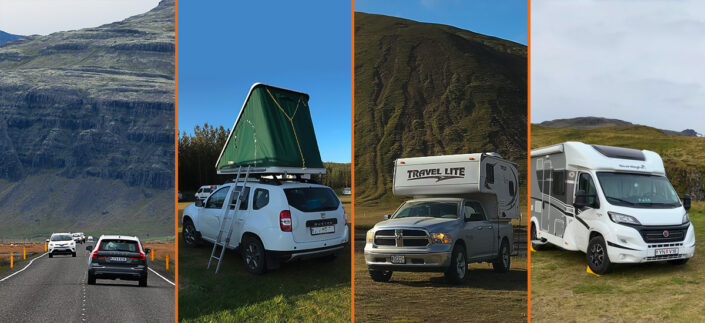
Renting a car in Iceland: a Complete Guide
For autumn, winter and spring we definitely recommend renting a regular car and staying in hotels, hostels or guesthouses. While you can sleep well in a tent or campervan at any time of year, everything else – cooking, eating, taking shower, playing cards etc will be a lot more comfortable in a brick-and-mortar accommodation. Motorhomes (RVs) are generally not rented for winters and the strong wind gusts of spring and autumn make them a bit of a risk to rent then.
In summertime however, all options are a go. Staying in hotels is still more comfortable than camping, but camping is obviously much more affordable. Winds are not too bad (generally), so driving a large campervan or motorhome is also OK. A huge advantage of camping (so sleeping in a tent, campervan or motorhome) is its flexibility. You don’t need to book camping parcels in advance, and you can freely readjust your itinerary on the go. Only the electricity parcels for RVs require advance booking, but even then booking them a day or two in advance is perfectly enough.
We go through this in a lot more detail in this article: Renting a Car in Iceland – a Complete Guide.
Accommodation – where should you sleep
As mentioned before – tents, campervans and motorhomes work great in Iceland, but mostly in the summer months. Other than that you really want to sleep under a solid roof. From October to April the night air temperatures often approach 0 ºC (32 ºF) and in winter they can fall below -20 ºC / -4 ºF at ground level. So as said before: while sleeping itself might be OK if you trust your sleeping bag, then cooking, eating, playing cards, etc. may be quite uncomfortable.
R
emember it is illegal to wild camp in anything else than a ground tent in Iceland. And even for the ground tents there are some restrictions. You’re not allowed to park your campervan anywhere you want and spend the night there. You might get away with it, but it’s not legal.
As also mentioned above – it’s not a good idea to make a “base camp” in Reykjavik and go on day tours from there. You’ll do a lot of unnecessary driving and just waste a lot of time if you do that. And some amazing places like Jokulsarlon Lagoon, Diamond Beach, Fjadrarsgljufur or anything on the Westfjords will be out of your reach.
You can spend your first or last night in Reykjavik, but other than that look for places to stay near Vik, Fludir, Borgarnes or Grundarfjordur to limit the needless driving to and fro.
You don’t have to book campsite parcels in advance at all. But you do have to book hotels and hostels in advance, if you travel between May and September. Outside of these months you can generally book your rooms as you go, but in the high season 3 to 6-month advance is definitely advisable. From mid June to late August some places sell out even earlier than that, so it’s a good idea to book your stays as early as possible.
If you’re planning to stay in one of the highlands’ huts (like the Landmannalaugar hut or any of the Thorsmork huts), then you need to book that well in advance. Even nine months advance is often NOT enough there. Bookings for most of the huts open in October previous year and they sell out within days. Usually you can find some availability later than that, but it’s not uncommon to book your huts first, and only then look for corresponding flights and plan everything else around that…
Hotels in Iceland are very much like hotels elsewhere in the world, although they are small to medium. You won’t find the really large ones here. Guesthouses usually offer 2-person rooms, but you can find larger ones if you want to. You’ll have access to a shared kitchen there, too. Hostels are based on large dormitories, but will often offer private rooms too (for 2, 4 or 6 people). Bare in mind that in some of dormitories/hostels all beds are double. Some of them are just great (see The Barn in Vik), but if you travel solo, that’s probably not for you, really.
If
you decide to stay in hotels, the room rate is only half of your costs. Since you can’t cook and have to rely on hotel restaurants for dinners, the total cost grows significantly. Hotel food is (usually) very good in Iceland, but see the table below – those dinners might even double your total accommodation cost.
A very interesting type of accommodation in Iceland is camping pods (like the Fossatun Camping Pods). It’s sort of a small hut, but with no bathroom or kitchenette inside. It’s heated, so you sleep in warmth, and you can bring your own sleeping bag or rent bed linen for a small fee. A really great choice for backpackers, as every few days you really want to dry your clothes properly.
Some hotels, guesthouses and even camping grounds will offer a free of charge hot pool for all their guests. Those are usually just really large outdoor jacuzzis, but certainly a nice touch.
Food: self-catering or eating out?
On a day-to-day basis, it’s certainly most affordable to cook on your own, mostly at the end of the day, in shared campsite or hostel kitchen. Grocery stores in Iceland are well stocked, and prices are reasonable. If you’re coming from another EU country, you can also bring most of your food with you.
Just keep in mind that outside the larger cities, stores are not open for very long, and those with alcohol – Vinbud – are sometimes open briefly and at very “non-touristy” hours. For more on stores and shopping in Iceland, read the article Grocery Shopping in Iceland: Prices and Store Opening Hours.
As a small snack during the day, it’s sometimes worth indulging in a hot dog at a gas station (usually around $5). Once or twice, it’s also worth enjoying local specialties. The taste of pickled shark is one of the strongest memories for many visitors to Iceland 🙂 Local specialties are not cheap, but they are so unusual that they are definitely worth trying. It’s also one of the best reasons for spending a little more time in Reykjavik. For details, see here: Iceland for Foodies – What’s Worth Trying and Where.
How much is a self drive in Iceland (approximately)
Unfortunately, Iceland is one of the most expensive countries in the world and it is difficult to see its attractions on a shoestring budget. Flights, accommodation, car rentals and guided tours are all quite expensive here, especially in the high season. Hiking with a tent is relatively inexpensive, but other than that, Iceland is not cheap to visit.
I
nterestingly, as presented in the table below, on a shoestring budget a trip to Iceland should cost you around $900 per person, regardless of the season you’re going.
Compared to May, in wintertime everything is less expensive, but you want to visit an ice cave, and that drives your costs up. While in the summer most everything is more expensive, but you can save a tonne of cash by camping in a tent. And so the total cost stays constant.
If you want to stay in hotels, drive a good car and see everything there is to see, your costs will be significantly higher. You’ll enjoy the trip a lot more, for sure, but it will cost you. A relatively easy way to cut the costs, but not the fun, is to book accommodation in places with kitchen access. Hotel dinners are really great, but they do drive the cost way up.
Motorhomes / RVs are also a reasonable option. You should be able to find a nice RV for about $3,000 for 5 days in July and a campervan for about $2,000. And that allows you to keep your July car & accommodation costs at or below May levels (as per table below). Plus you can cook for yourself, so that’s also less expensive. We don’t recommend motorhomes and campervans outside of summer, but you can absolutely do that too.
| Total costs of a trip for 4 people to Iceland for 5 days (2024) |
|
February |
May/October |
July |
|
shoestring |
quality |
shoestring |
quality |
shoestring |
quality |
| car |
$250 |
$400 |
$300 |
$550 |
$600 |
$1,050 |
| fuel |
$230 |
$300 |
$230 |
$300 |
$230 |
$300 |
| accommodation |
$1,000 |
$2,500 |
$1,000 |
$2,500 |
$500 |
$4,200 |
| flights |
$800 |
$1,200 |
$1,000 |
$1,400 |
$1,200 |
$2,000 |
| food |
$250 |
$2,500 |
$250 |
$2,500 |
$250 |
$2,500 |
| attractions |
$950 |
$1,400 |
$700 |
$2,200 |
$700 |
$2,200 |
| Total costs |
$3,480 |
$8,300 |
$3,480 |
$9,450 |
$3,480 |
$12,250 |
| Costs / person |
$870 |
$2,075 |
$870 |
$2,360 |
$870 |
$3,060 |
Table notes: shoestring vs quality (click to expand)
shoestring budget:
- compact 5-pax FWD car with basic insurance
- promo flight tickets
- staying in hostels, camping in summer
- minimum guided tours (lava cave + ice cave (winter) or classic whale watching (non-winter))
- self-catering only
- all things booked min. 6 months in advance, on special promos
quality budget:
- intermediate SUV 4×4 car
- regular flight tickets – economy class, no special promo
- staying in double rooms at mid-range hotels, breakfast included
- 2 reasonable guided tours, Perlan entry, 2x hot lagoon entry
- breakfasts included in room price, dinners at hotel restaurants
- all things booked ca. 3 months in advance, on regular rates
Recommended reading
When preparing for a trip to Iceland, it’s surely worth your while to read our top backgrounders and guide articles. Here’s our top picks:
If you are interested in guided tours, here’s our broad selection of day tours, as well as multi-day tours and airport tranfers.
Finally – if you have any questions: ask them in the comments. We will try to answer as soon as possible 🙂 Have a great trip!

